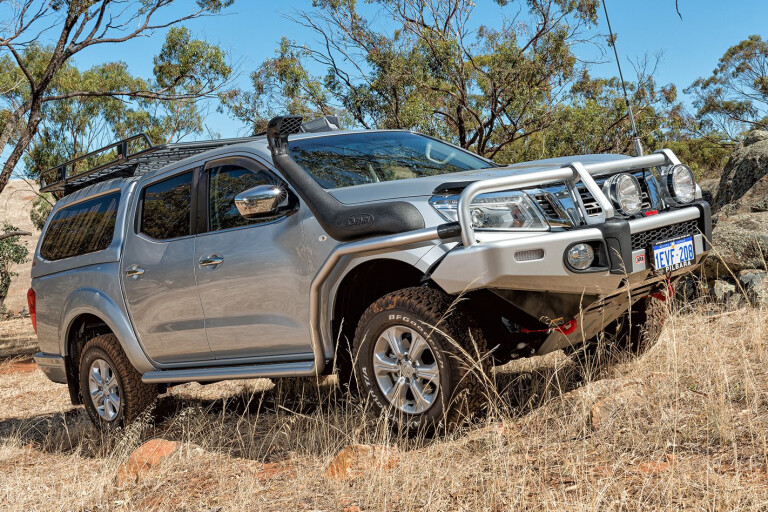
When it comes to multitasking, the once-humble dual cab ute now provides a high level of functionality, with manufacturers spending countless hours and huge budgets to ensure vehicles can perform acceptably in a large range of conditions.
But there’s always a point of compromise to appease the many different consumer needs – meaning your typical dual cab is an excellent base for a few aftermarket tweaks.
This article was originally published in the Utes 2016 issue of 4X4 Australia.
Unless you have a bottomless bank balance or major sponsor, make sure you carefully option-up based on what you’ll be doing with your vehicle, not what will impress the neighbours. A massive winch hanging off the front looks mean, but it’s not what you need if you’re sticking to well-formed tracks.
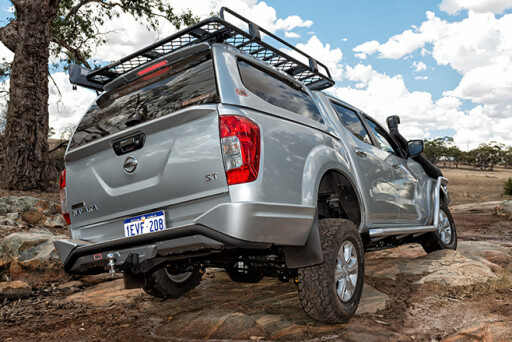 Running a set of light-truck all-terrain (A/T) tyres is one of the easiest ways to improve off-road capability. Showroom tyres are generally road-biased for quiet performance and passenger comfort. A light-truck all-terrain, however, is a more robust tyre than its highway counterpart.
Running a set of light-truck all-terrain (A/T) tyres is one of the easiest ways to improve off-road capability. Showroom tyres are generally road-biased for quiet performance and passenger comfort. A light-truck all-terrain, however, is a more robust tyre than its highway counterpart.
Stronger sidewalls allow it to cope with higher loads, better withstand reduced pressures (where sidewalls flex), and allow it to mould to the terrain. A light-truck design also offers greater resistance to puncture, and the generally more aggressive tread pattern of an all-terrain tyre will aid traction for off-road conditions.
The BF Goodrich All-Terrain T/As fitted to this Navara NP300 have a square-edge profile that offer bite in muddy conditions and a good self-cleaning action, while the TriGuard three-ply sidewalls offer much needed extra strength.
 You can complete your tyre set-up with a tyre gauge and a quality air compressor. Some people choose a vehicle-mounted unit with a switch in the console, so by the time they’re out of the cab and have hooked up the air line, it’s ready to go. For others, a toolbox-mounted compressor offers greater versatility.
You can complete your tyre set-up with a tyre gauge and a quality air compressor. Some people choose a vehicle-mounted unit with a switch in the console, so by the time they’re out of the cab and have hooked up the air line, it’s ready to go. For others, a toolbox-mounted compressor offers greater versatility.
If you don’t need to carry objects higher than the roof line, then a canopy gives your dual cab plenty of station wagon functionality – but with more load space. Also, a canopy protects your gear from weather and thieves.
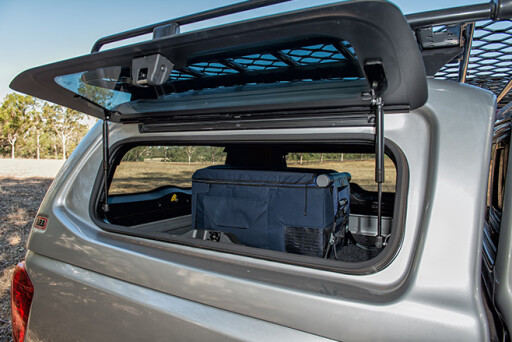 Modern design and construction standards means a canopy should complement the vehicle’s lines with an OEM look and finish. Consider whether you want to carry a roof-top tent or prefer the functionality and practicality of a roof rack, and make sure the canopy can support the load. This Navara canopy has an integrated support frame to support a roof load of 100kg.
Modern design and construction standards means a canopy should complement the vehicle’s lines with an OEM look and finish. Consider whether you want to carry a roof-top tent or prefer the functionality and practicality of a roof rack, and make sure the canopy can support the load. This Navara canopy has an integrated support frame to support a roof load of 100kg.
It cleverly negates the need for a separate frame, which can impede side window access or restrict the loading area. A roof-mounted vent creates positive pressure within the canopy to reduce dust. The canopy may also be synced into the vehicle’s central locking and operated by the standard key remote.
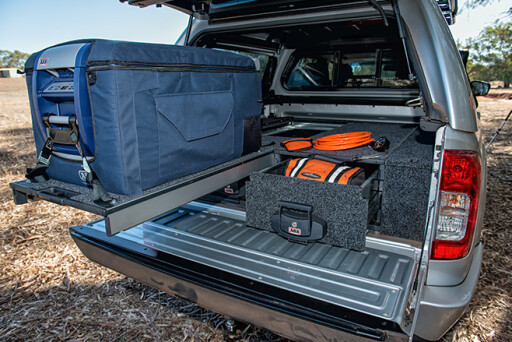 Murphy’s Law suggests that when you’re halfway to your destination you’ll probably need to access the tools for something. What are the odds they’ll be at the bottom of the pile?
Murphy’s Law suggests that when you’re halfway to your destination you’ll probably need to access the tools for something. What are the odds they’ll be at the bottom of the pile?
If unloading everything road-side isn’t appealing then consider rear storage drawers, especially to house heavier items down low and to provide easy access. The side areas next to drawers are also perfect for mounting a water bladder or second battery, and you get a flat load floor.
A good drawer system is a compromise between weight and construction. The drawers have to be solid enough to cope with carrying heavy gear across bouncing corrugations without falling apart and they must slide easily when loaded and be able to lock in to place and support contents when extended.
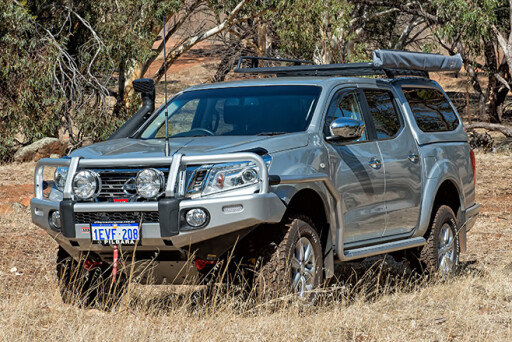 Quality latches with easy to operate handles and recesses to avoid jamming your fingers are must-haves! A one-step lock-and-slide handle on the fridge slide is nifty, but shorter adventurers – or those travelling with kids – could benefit from a drop-down slide. Or, rather than the side-by-side drawer configuration, use a drawer stack and fit the fridge lower for easier access (or to allow for a taller fridge).
Quality latches with easy to operate handles and recesses to avoid jamming your fingers are must-haves! A one-step lock-and-slide handle on the fridge slide is nifty, but shorter adventurers – or those travelling with kids – could benefit from a drop-down slide. Or, rather than the side-by-side drawer configuration, use a drawer stack and fit the fridge lower for easier access (or to allow for a taller fridge).
If your dual cab is primarily a tow tug for light off-roading, stop now. Your work is complete. You’ve improved the practicality of your rig and there’s no need to spend more.If you want to tackle more significant off-road obstacles, then your typical dual cab, like this Navara, can be limited by its showroom suspension, especially when loaded.
 The first thing you usually learn about at the school of hard scrapes is the importance of ground clearance when negotiating off-road terrain – especially with a long wheelbase. Even for moderate undulations or obstacles, an inch or two (25 to 50mm) can make a world of difference.
The first thing you usually learn about at the school of hard scrapes is the importance of ground clearance when negotiating off-road terrain – especially with a long wheelbase. Even for moderate undulations or obstacles, an inch or two (25 to 50mm) can make a world of difference.
Suspension tuning is not just a matter of bolting on stiffer shocks and springs, as – if incorrectly matched – they will have a detrimental effect on ride quality and handling. Plus, you need to decide on the primary use of your vehicle to ensure you choose the right suspension specification.
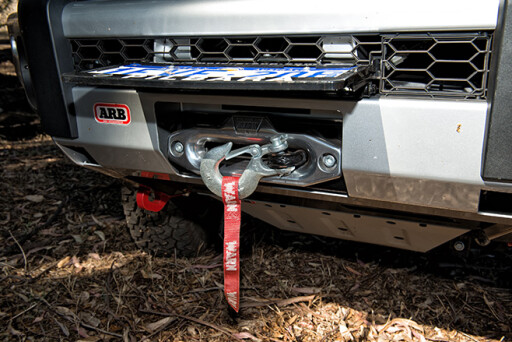 For the front of Nissan’s NP300 Navara, Old Man Emu (OME) has developed three specs: one for vehicles with no bar work; another for vehicles fitted with a bar; and the third for vehicles with bar and winch combos. With a moderate 30mm lift all-round on this vehicle, the factory geometry on the front suspension is well within the working range of the upper control arm.
For the front of Nissan’s NP300 Navara, Old Man Emu (OME) has developed three specs: one for vehicles with no bar work; another for vehicles fitted with a bar; and the third for vehicles with bar and winch combos. With a moderate 30mm lift all-round on this vehicle, the factory geometry on the front suspension is well within the working range of the upper control arm.
The OME front damper units take advantage of a small amount of extra travel available in the Navara’s standard suspension, to provide an additional 10mm. The shocks are tuned to match spring rates to provide the best balance between ride comfort, handling and travel.
For the rear coils, there are several options tuned for expected loads of 200kg, 400kg and 600kg. The rear shocks offer an additional 30mm of travel and are available in two configurations: one for comfort and control off-road, the other for load-carrying control. There’s also a small mod for the sway bar to compensate for the extra travel.
 On the black top, the Navara’s OME ride is comfortable and compliant, easily dealing with small irregularities and bumps. The added weight of accessories, bar work, winch, roof rack and drawers gives the Navara a slightly heavier feel, but push it into a corner and the OME suspension does its best to brighten the Navara’s lacklustre factory steering response that provides a feeling of rolling around corners rather than turning through them.
On the black top, the Navara’s OME ride is comfortable and compliant, easily dealing with small irregularities and bumps. The added weight of accessories, bar work, winch, roof rack and drawers gives the Navara a slightly heavier feel, but push it into a corner and the OME suspension does its best to brighten the Navara’s lacklustre factory steering response that provides a feeling of rolling around corners rather than turning through them.
Turn on to the dirt where the steering issue is less relevant and the suspension proves a winner. The Navara flexes up easily; the extra travel and lift negotiates rocky outcrops, wash-outs, muddy creeks and steep gullies that would probably stop a standard Navara in its tracks.
 If you unlock the potential of the Navara and start playing harder off road, you might want to consider a little protection. Fit something like the ARB colour-coded front bar, side rails and rear step bar to transform your ute from mundane to muscular, with integrated showroom style, fit and finish.
If you unlock the potential of the Navara and start playing harder off road, you might want to consider a little protection. Fit something like the ARB colour-coded front bar, side rails and rear step bar to transform your ute from mundane to muscular, with integrated showroom style, fit and finish.
We like the front bar’s solid steel construction and upswept wing design; it improves approach angles, while the pivoting number plate frame hides the winch neatly. The replaceable side step covers are smart, too – no more permanently dull chequer plate. The flap on the rear step bar cleverly conceals mounting points for the trailer plug, Anderson plug or power-mounting point to run an air compressor.
 The side rails and step offer protection for the front-quarter guards and side sills, in case you slip sideways and rest against a tree. The rear step offers protection for the corners of the vehicle body and provides easy access to the roof rack. The rear number plate also pivots for spare wheel access, and a 50mm hitch receiver is ready to hook up a camper trailer.
The side rails and step offer protection for the front-quarter guards and side sills, in case you slip sideways and rest against a tree. The rear step offers protection for the corners of the vehicle body and provides easy access to the roof rack. The rear number plate also pivots for spare wheel access, and a 50mm hitch receiver is ready to hook up a camper trailer.
This Navara is also fitted with underbody protection covering vital components, from the front bar to the transfer case. There’s the option to install one or two recovery points designed for the Navara and matched to the front bar.
It makes sense to use an auxiliary battery to power accessories including the fridge and camp lights. To ensure proper charging of the second battery, electrical duties are capably met on this NP300 by a Redarc BCDC1225 25-amp in-vehicle battery charger. Redarc’s new multifunction LCD/LED gauge is neatly mounted in the side panel of the rear roller draws to monitor battery status.
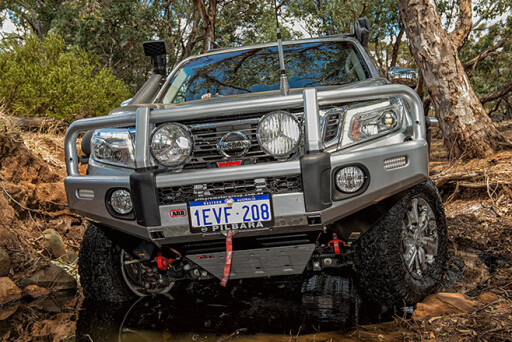 IPF Xtreme LED Sport lights show the way at night. With one spot and one spread unit to give the best combination of distance and side coverage, they brighten the road side and extend a tunnel of light well into the distance. IPF says the LED Sport lights are lighter and produce less heat than conventional multi LED lights, thanks to the use of only three LEDs. According to IPF, this also results in them only drawing 25W, while maintaining a consistent colour of 6500 Kelvin – good for your eyes.
IPF Xtreme LED Sport lights show the way at night. With one spot and one spread unit to give the best combination of distance and side coverage, they brighten the road side and extend a tunnel of light well into the distance. IPF says the LED Sport lights are lighter and produce less heat than conventional multi LED lights, thanks to the use of only three LEDs. According to IPF, this also results in them only drawing 25W, while maintaining a consistent colour of 6500 Kelvin – good for your eyes.
Given that dual cabs are a significant investment, whatever gear you select needs to do your vehicle justice. Choose quality products and do it all at once, or build things slowly – as your budget allows – to transform your ute into a capable off-road tourer.


COMMENTS